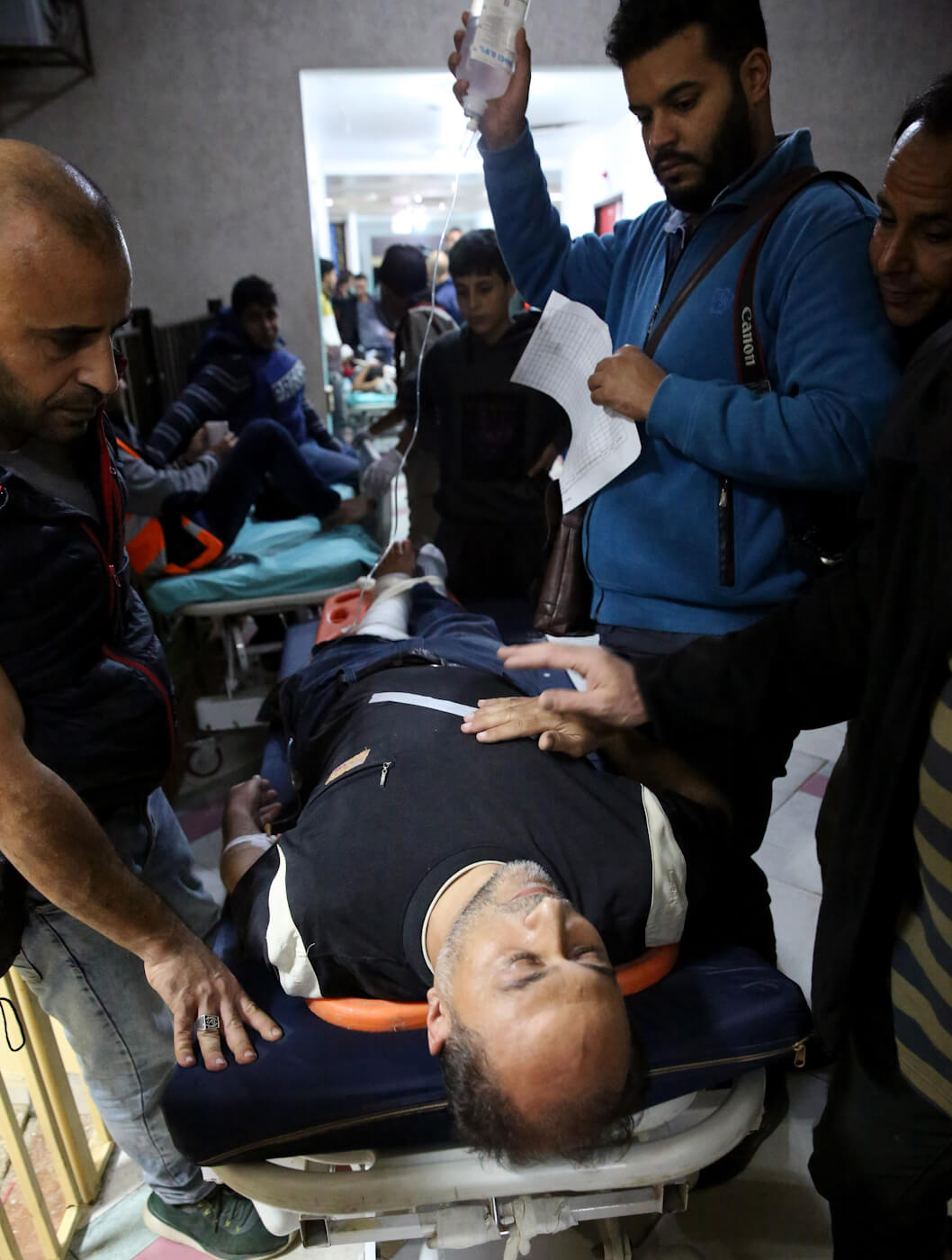GAZA CITY — An Israeli military sniper shot and gravely wounded a Palestinian cameraman working for the Associated Press. Rashed Rashid was shot in the leg on Monday during protests in the Gaza enclave, resulting in multiple fractures above the ankle that will require surgery, he is expected to survive.
At the time of the shooting, Rashid had been wearing a blue helmet and brown protective vest with the word “PRESS” clearly marked in white. He was also standing nearly 600 meters away from protesters on an elevated area, operating a large camera. The Israeli military has stated that it is investigating the incident.
Rashid is at least the sixteenth Palestinian journalist to be shot by Israeli forces while wearing a press vest since the Great Return March – a popular protest against the decade-long blockade of the Gaza Strip and in favor of the right of return of Palestinian refugees to Palestine — began earlier this year in March.
In the first few months of the demonstrations along the Gaza border, journalists Yasser Murtaja, Ahmed Abu Hussein, Yousef Kronz, Mohammad al-Thalatini, Mahmoud Bassam, Yasser Qudeih, Deyaa Abu Aoun, Motasem Ahmed Dalloul, and several others were all shot by Israeli snipers while they wearing press vests and positioned far away from demonstrators. Murtaja and Hussein died as a result of their injuries and Kronz had his leg amputated after he was refused passage to a West Bank hospital by Israeli authorities.
AP cameraman shot during Gaza protest — “Rashed Rashid, 47, was hit in the leg during a weekly protest next to the Israeli border. Doctors said he suffered multiple bone fractures above the ankle and would need surgery.” https://t.co/zinXqInoeq
— Jacob Burns (@JacobTBurns) November 20, 2018
Rashid is the most recent Palestinian journalist with a press vest to be shot by the Israeli military and was one of 25 people injured by the Israeli forces, which used tear gas and live rounds in an attempt to disperse the demonstrations on Monday. The IDF has claimed that the demonstrations involved Palestinians “rioting” by throwing rocks and an alleged “explosive device.”
Since the demonstrations began, the IDF has killed over 200 people – including journalists, medics, children and an infant – and wounded over 22,000. In contrast, since the last major war between Israel and Gaza in 2014, the IDF’s Gaza Division has suffered just two fatalities.
The Israeli government has repeatedly stated that the Great Return March protests are a ploy by Hamas, which has governed the Gaza Strip since winning elections in 2007, to provide cover for its alleged efforts to “breach the security fence” between Gaza and Israel. Israel has also claimed that the majority of those shot by the IDF over the past several months are “terrorist operatives affiliated with terrorist organizations, primarily Hamas.”

Colleagues help AP cameraman Rashed Rashid, 47, who was shot by an Israeli sniper in Gaza, Nov. 19, 2018. Adel Hana | AP
Former Israel Defense Minister Avigdor Lieberman – who resigned last week due to his outrage after a ceasefire was brokered between Gaza and Israel — has asserted that there are “no innocent people” in Gaza, despite the Strip being home to one million adolescents and children. In addition, Israel Justice Minister Ayelet Shaked has claimed that the only way for the Gaza border to be “completely quiet” would be for Israel “to conquer the Strip.” Shaked recently noted that she expects the current ceasefire to hold for only a few months and that the ceasefire will be followed by a major IDF military operation in Gaza.
A glaring double-standard
Despite the fact that Israel has wounded and killed several journalists who were clearly marked as media workers, there has been little international outrage over Israel’s repeated targeting of journalists both in Gaza and in the occupied West Bank — even though many of the journalists shot have worked for major international news organizations like the Associated Press and Middle East Monitor, among others.
In contrast, mainstream international news organizations continue to devote considerable attention to the death of Saudi journalist Jamal Khashoggi, who was murdered last month in the Saudi consulate in Istanbul.
Since then, several other journalists in the Middle East have been killed or targeted by repressive Middle Eastern governments, including Saudi Arabia and Israel, but have received little or no coverage. In Israel’s case, the consistent lack of coverage of its documented practice of targeting Palestinian journalists with live rounds has resulted in the perpetuation of Israel’s culture of impunity, which in turn has allowed Israel to continue targeting journalists and commit other war crimes without fear of reprisal from the international community.
Top Photo | Colleagues help AP cameraman Rashed Rashid, 47, who was shot by an Israeli sniper in Gaza, Nov. 19, 2018. Adel Hana | AP
Whitney Webb is a staff writer for MintPress News and a contributor to Ben Swann’s Truth in Media. Her work has appeared on Global Research, the Ron Paul Institute and 21st Century Wire, among others. She has also made radio and TV appearances on RT and Sputnik. She currently lives with her family in southern Chile.
The post IDF Shoots AP Cameraman in Press Vest Covering Gaza Protests appeared first on MintPress News.
